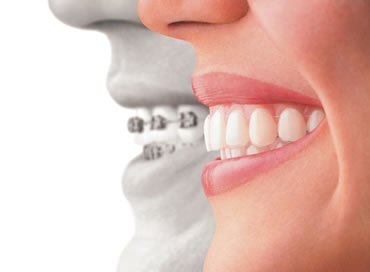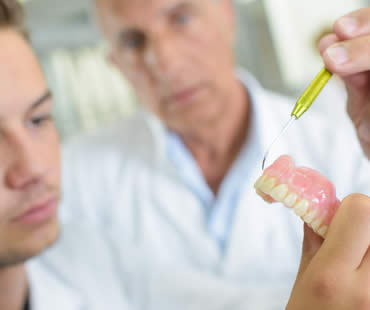
Everyone wants to have a whiter, healthy smile. Home teeth whitening has become an extremely popular means to achieve those pearlier whites in the past couple of decades. In many cases, over-the-counter whitening kits are effective and safe. However, there are some disadvantages and risks to using over-the-counter home whitening kits:
- Off-brand whitening kits often contain dangerous concentrations of bleach or peroxide. This can cause erosion of the tooth enamel, and irritation to the sensitive gums and soft tissues of the mouth.
- Because many kits contain trays that do not adhere properly to your teeth, gums can become irritated and chemicals can leak out and be ingested causing stomach problems.
- Poorly fitted trays and varying concentrations of chemicals from lower quality kits may also result in unwanted discoloration of teeth or uneven results.
- Exposure to excessively harsh chemicals in off-brand kits can also cause gum shrinkage and oral infections.
When considering at-home whitening, it is best to stick to name brand kits to ensure the quality and safety of the treatment. Many popular brands of kits are both safe and efficient when used as directed. In any case, you should not consider at-home whitening if any of the following apply:
- You have deep, untreated cavities.
- You are pregnant.
- You suffer from gum disease.
The safest and most effective method for whitening your teeth is to have treatment by a dental professional, either in-office or with professional take-home trays. A qualified dentist can whiten your teeth up to ten shades in as little as one office visit. Consult with your dentist before pursuing any type of whitening treatment to ensure you will achieve the whiter smile you desire in the safest and quickest manner possible.
Our dental office is located in Haymarket

Does your smile need some work? Are you sensitive about your teeth and how you may look while you eat or drink? Does speaking in public leave you anxious because you’re worried about the appearance of your teeth? Have you been putting off talking to a cosmetic dentist because you’re worried about the dental therapies you might need? Don’t be afraid of a smile makeover! A smile makeover can be a simple thing, as minor and fast as teeth whitening, a process that can often be completed in-office in a single visit.
If you are looking for solutions to your smile problems, begin by finding a skilled cosmetic dentist. You want to be sure to see photographs of some of the actual work done by a particular cosmetic dentist. Don’t assume that what you see online are actual patient photographs – they may be someone’s patients, but if they weren’t this dentist’s patients, you’re not getting any closer to identifying the right cosmetic dentist for you.
Ask around for private recommendations from friends and family; it might surprise you how many people you know have had work done to their smiles. You might assume that your coworker’s smile is all natural, only to learn it’s the result of a skilled cosmetic dentist and veneer work done so carefully and well that they look just like natural teeth.
Dental veneers can transform your smile in only a few visits. Good veneers will be made of materials that mimic the color and translucency of natural teeth. They won’t look puffy, too long or artificial and will complement your hair and skin color. Orthodontia can change the alignment of your teeth, with choices such as Invisalign to help you feel more confident as you change your smile.
A smile makeover can benefit you in so many ways by simply boosting your self-confidence. After you complete your treatment, you will be surprised at how much better you feel about yourself and about life in general. You will face the day with confidence, knowing you can live your life without worry about your smile.
Dr. Anju is a cosmetic dentist in Haymarket offering smile makeovers.

Veneers are a great solution for many people who are unhappy with their smiles and want a permanent improvement. These thin porcelain shells are bonded to the surface of teeth to make the smile more appealing. You and your dentist can choose the shade you prefer, and a minimal amount of preparation is required before attaching the veneers.
Many kinds of problems disappear with dental veneers. Some of the common reasons that people choose veneers include:
- tooth discoloration or staining
- crooked teeth
- worn teeth
- too much gums visible
- uneven teeth
- misshapen teeth
- bite problems
- overly sensitive teeth
No matter what flaws you might be getting dental veneers to hide, these restorations offer a number of advantages:
- Your real teeth may look unhealthy and damaged, but covering them with veneers gives them a healthy glow of a well-cared-for smile.
- Veneers look very natural, because the porcelain material is translucent and offers a glassy appearance.
- Porcelain resists stains so your smile will stay as white and bright as the day you got the veneers.
- Veneers last anywhere from ten years to a lifetime, depending on the quality of the application and your proper maintenance of them afterwards.
- There is no special care required other than your usual brushing and flossing routine.
- Veneers can increase your self-esteem, since you can feel confident that your smile is the best it’s ever been.
If you need a dentist in Haymarket contact us today

One of the most recent innovations in modern orthodontics is Invisalign. These unique clear aligners are becoming increasingly popular for improving smiles without the stigma associated with traditional braces. Invisalign aligners straighten teeth by placing gentle pressure on them to move into better positions. This solution offers distinct advantages to some of the other options in orthodontics.
Hidden appearance:
One of the most obvious benefits of Invisalign is that the clear plastic is practically invisible in your mouth. The subtle appearance of the retainers is much less obtrusive than traditional metal braces. For patients who want to diminish the fact that they are undergoing orthodontic treatment, Invisalign in the perfect solution. Personal and professional relationships are not at risk of embarrassment due to being self-conscious about your smile.
Easy removal:
You will remove aligners from your mouth when eating or performing oral hygiene tasks. There are no impacts to your diet during Invisalign treatment, since you take out the aligners anytime you eat. Brushing and flossing are performed normally without having to worry about cleaning food debris out of intrusive wires and brackets. This can have positive impacts on your oral health as well.
Increased comfort:
The lack of metal pieces in the aligners means a more comfortable experience. Traditional braces have a reputation for poking the mouth or breaking. Invisalign offers a clear advantage of being very comfortable when worn.
Boosted confidence:
No matter if you are a teenager or an adult wearing braces, it can be embarrassing to have a mouth full of metal in your smile. The invisible quality of Invisalign eliminates those self-conscious feelings, giving you the confidence to smile, laugh and eat as usual even while undergoing treatment.
If these benefits of Invisalign sound appealing to you, schedule an appointment with a qualified orthodontist who provides this type of treatment. It may be the winning route to your beautiful smile.
If you live in the Haymarket area contact us today

There are a number of reasons that dentists or oral surgeons recommend surgery, but facial injuries are probably the most unexpected and alarming cause. Maxillofacial injury, or facial trauma, refers to any injury to the mouth, jaw, and face. Most of these injuries result from sports, car accidents, job accidents, violence, or an accident at home. Let’s learn about oral surgery resulting from facial trauma.
Broken bones are a common type of serious facial injury. Fractures can occur in the upper or lower jaw, cheekbones, palate, and eye sockets. Injuries in these locations may affect vision and the ability to eat, talk, and breathe. Hospitalization is often required for treatment, which is similar to that for fractures in other parts of the body. The bones must be lined up and held in place to allow time to heal them in the correct position. Because casts are not possible in facial injuries, the surgeon may use wires, screws, or plates to treat fractures. Sometimes healing takes as long as six weeks or more.
Even though some facial injuries are worse than others, all of them should be taken seriously. They affect an important area of the body, so it is recommended to seek treatment from an oral surgeon to make sure you receive optimum care. Even if stitches are all that’s required, it’s best to have them performed by an oral surgeon who can place them exactly as needed to produce the best results.
It’s no surprise that the best solution for facial injuries is to prevent them in the first place. Oral surgeons suggest consistent use of mouth guards, seat belts, and masks and helmets as required. Improvements have been made to safety gear to make these items more comfortable and efficient, so there should be no excuses for not using them to protect yourself and avoid injuries that can lead to oral surgery.
If you live in the Haymarket area contact us today

An implant overdenture combines the use of traditional dentures and implant technology to create a denture that fits over your remaining natural tooth roots or dental implants. These root or implant supported dentures are held in place by dental attachments which provide excellent stability and support for your dentures. Overdentures were developed to help patients missing some or all of their teeth regain a quality of life that may have been lacking since they lost their teeth.
There are several benefits to implant overdentures when compared to traditional dentures:
- Saving your natural roots or having implants placed slows bone loss by stimulating the bone in your jaw when you eat or chew.
- Because overdentures are better fitting by design, they are more stable and allow you to chew food more thoroughly. This promotes better digestion and allows you to absorb more nutrients.
- The increased stability provided by overdentures also means you are able to speak more clearly, as there is no slipping or clicking of your dentures.
- Loose dentures are not a worry with overdentures. Sticky adhesives and messy denture creams are unnecessary when you have implant overdentures.
- With overdentures, the natural shrinkage that occurs from an under-stimulated jaw does not occur. This keeps your face from looking sunken, as can often happen with traditional dentures.
To find out if you are a candidate for implant overdentures, schedule an evaluation by your dental professional. Overdentures could be the best, most natural treatment for restoring your oral health and beautiful smile.
We treat patients from Haymarket and the surrounding area










